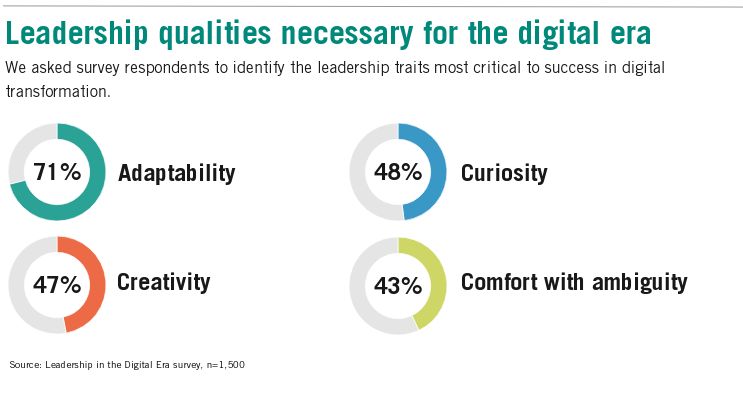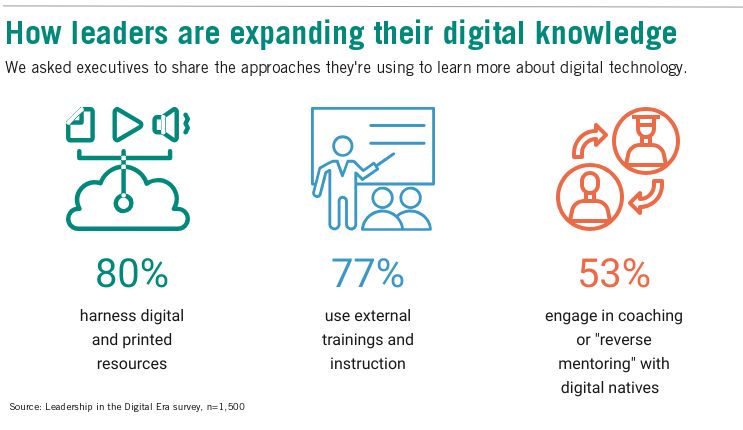Transforming an organization starts with transforming its leaders. Data from 1,700 executives by Linda Hill and colleagues reveals the most important skills and traits leaders need now.
Leaders who set out to reshape their companies to compete in a fast-evolving digital world often come to a daunting realization: To transform their organizations, they must first transform themselves.
However, the qualities they need to develop aren’t the ones you might expect. You might think an organization in flux needs a steady hand, someone with foresight and experience who plots a sensible route to cautiously and competently travel. And, of course, companies need leaders who are also digitally literate, right?
In actuality, our research highlighted that none of these characteristics matter as much as you might think when it comes to leading digital transformation. In fact, 71 percent of 1,500 executives we surveyed in more than 90 countries said that adaptability was the most important leadership quality in these times.
Our survey respondents also ranked creativity, curiosity, and comfort with ambiguity as highly desirable traits. “It’s the soft skills that I argue are not soft anymore,” said the chairman of a major African retailer at one of the 21 global roundtable discussions we held with leaders of digital-first and incumbent companies.

More troubling, though, was that fewer than half of our participants think that they or other senior executives at their organizations have the right mindset and skills to lead in the digital era. Those closer to the nuts and bolts of digital functions—the chief technology officers, chief information officers, and chief digital officers—feel more confident about their own capabilities but less so about those of their colleagues in other functional areas.
In light of the speed at which new technologies continue to emerge, digital transformation is not a one-and-done process, and neither is the leadership transformation required of leaders. Here’s our advice, based on our research, for leaders trying to recalibrate:
1. Be a catalyst, not a planner
In the digital era, companies face a more dynamic competitive environment: key competitors are no longer the usual suspects, and customer and stakeholder expectations continue to evolve. The speed and complexity of technological change require digital transformations to be more iterative than other forms of corporate change.
Leaders need to catalyze change rather than plan for it. That means creating the initial conditions for the organization to achieve its ambitions and guiding their company through a process of continual learning, pivoting all along the way.
Though it won’t be easy, even perfectionist Type-A personalities must open their minds to a more experimental approach. Those who rely on traditional strategic thinking—an approach one roundtable executive described as “linear and deterministic”—will be less attuned to emergent factors to which they must respond.
“LEADERS WILL BE BLINDSIDED IF THEY RELY ONLY ON THEIR PAST EXPERIENCE OR EXPERTISE WHEN MAKING DECISIONS.”
Leaders must be comfortable moving forward with ambiguous and incomplete information about what’s happening around them and the potential impact of their actions. They must learn to see their decisions and actions as working hypotheses that they can only validate by collecting feedback on their impact as expeditiously as possible.
Leaders will be blindsided if they rely only on their past experience or expertise when making decisions. Even with more data and analytics, executives we talked to said that leaders still need to adopt holistic thinking and stay open to the unexpected. They must learn to stretch their “own imagination and creativity” to envision what the future could be for the company and its stakeholders, anticipate possible scenarios, and prepare to adapt to whatever unfolds.
It is important for leaders to think and act with an outside-in perspective, cultivating a 360-degree view of the dynamics within their organizations as well as of those of the ecosystems in which they operate. This requires what Harvard Business School professors Tarun Khanna, Anthony Mayo, and Nitin Nohria refer to as contextual intelligence. Only with an understanding of the most salient information or the most influential players in a given context can an executive figure out how to catalyze change rather than plan for it.
2. Trust and let go
In today’s world, vision and strategy are still essential, but the ability to orchestrate collective action—co-creation instead of top-down direction—has never been more important. To this end, leading in the digital era is an exercise in trust, executives said.
It’s about inviting employees to share in decision-making and creating a culture that makes people feel safe enough to take risks and act on behalf of organizational interests. It’s also about earning trust from and offering trust to increasingly diverse stakeholders outside of the organization and collaborating with them in new and uncharted ways. Trusting executives:
Distribute authority. It’s important to shake the command-control model, which depends on hierarchy and rules. Leaders must learn to exercise influence without relying on formal authority. They set the organizational compass—communicate the purpose and values—and empower others to execute.
Lean on others. We’re not talking about delegating to trusted lieutenants with similar backgrounds and the same life and career experiences. It means learning to collaborate with an increasingly diverse workforce across functions, levels, geographies, and even organizational boundaries.
“NO ORGANIZATION CAN GO IT ALONE.”
Curate talent. Expanding their traditional network of talent requires leaders who can identify and assess the capabilities, mindsets, and values of individuals the corporation needs to deliver on its purpose. This might entail nurturing digital natives (by definition, those younger than most senior leaders) to help them reach positions of significant authority (and even become board members). Elevating promising talent will help the company embrace the new and diverse perspectives necessary to go beyond the company’s core business to imagine growth platforms.
Build partnerships. No organization can go it alone. The COVID-19 pandemic reminds leaders of how organizational success depends on the resiliency of their ecosystems—a public sector able to provide basic infrastructure and a private sector able to provide critical resources and capabilities (e.g., a reliable supply chain). Leaders are discovering they must proactively invest in the ecosystem and build partnerships (turn vendors into partners; join with competitors to solve problems government can’t) to create the conditions for sustainable success.
3. Be an explorer
With so much changing around them, leaders must be explorers. One roundtable executive defines exploration as “curiosity in action.” An explorer searches with an ambition in mind: What questions must they answer to lead their businesses today and tomorrow? Where might they find the answers?
Leaders must balance this curiosity with intentionality as they figure out when to be open-minded and broad and when to be focused and dig deep. They must learn to pick up “weak signals” about what is happening in their organizations and ecosystems. By the time a weak signal becomes a trend, as one participant said, “you are often too late, especially when first-mover advantage is at play.” The best explorers:
Leave the office. Too often, participants acknowledged, senior leaders “live in a bubble.” Explorers go beyond their organizations and their usual experiences and relationships to figure out how the future might unfold. They realize and accept the limits of their knowledge and actively seek out the views of people with different lived experiences and perspectives. Explorers adopt what one executive calls a “software mindset,” committing to continual “personal upgrades.”

Stay humble. Leaders, even in digital-first companies, should have the humility to ask questions and learn from in-house experts and digital natives at different levels in the organization. Leaders must be familiar enough with emerging technologies in order to ask the right questions about opportunities, risks, and legal and ethical danger zones, and set the boundary conditions to guide the deployment of digital tools and data.
Roundtable participants who are digital natives expect executives to have a “basic appreciation” of the digital tools and data their organizations are leveraging, especially those related to cybersecurity, AI (artificial intelligence), and cloud services. In particular, they should appreciate the underlying logic of AI so they can interpret and evaluate data and the results of analyses with a critical, if not skeptical, eye.
Roundtable executives described learning what they need to know through regular meetings (both in-depth and more informal) with engineers developing and deploying digital tools for operations and customer-facing functions, for example. Some roundtable participants indicated that they plan to sign up for coding or data analytics classes to acquire expertise but, more important, to show their teams that they too must become life-long technology learners.
4. Be courageous
Leaders need to learn to experiment, iterate, and pivot themselves if their organizations are going to be able to thrive. In order to get comfortable with the inevitable missteps and unconfirmed hypotheses of experimentation, leaders need a new attitude toward risk. Eschewing opportunities just to avoid failure is perhaps the riskiest position of all in the digital economy. In a fast-moving world with more risks than ever—cybersecurity, reputational risks, pandemics, social crises—executives need courage to make big bets.
Executives we spoke to acknowledged that they mostly don’t feel psychologically safe, given the pressure they face from their boards and investors. However, if they want their employees to learn to live with the risk profile necessary for breakthrough ideas (as opposed to incremental choices) they must model what it means to act with courage and conviction: identifying as many risks as they can and working with their colleagues to mitigate them, while also having the fortitude to make hard decisions and move forward.
“LEADERS MUST GO FROM TRYING TO HAVE ALL THE ANSWERS TO BEING COMFORTABLE WITH BEING UNCOMFORTABLE.”
As roundtable participants pointed out, “standard safety vests” aren’t available; best practices are still up for debate for many aspects of digital asset and data use. Leading through uncertainty takes not only good judgment, but also the emotional resilience to shake off self-doubt and fear.
While digital natives and digital-first executives have experienced the benefits of “failing quickly and often,” leaders of less digital companies may find it hard to do so. Their outward confidence might mask fear and anxiety, but they must be ready to admit misconceptions and misinterpretations, and acknowledge early on what they don’t know or what isn’t working. Executives must be prepared to shoulder responsibility for mistakes and share credit for triumphs. One executive we interviewed said: “Leaders must go from trying to have all the answers to being comfortable with being uncomfortable.”
5. Be present
The leaders we talked to acknowledged just how complex and demanding work has become for employees in the digital era. Employees are expected to take on more risk as they experiment and innovate, and experience new human-technology interactions. As one leader put it, “everything about work and careers is being transformed.”
The best leaders stay present and emotionally engaged, communicating openly and authentically. During times of upheaval, these executives are:
Empathic. They monitor employee stress and anxiety and try to prevent overload and burnout, especially in the “next normal” of the pandemic. Many people are coping with social and economic unrest and insecurity both inside organizations and outside in their communities. Many people don’t feel safe. The best leaders show compassion by asking the right questions and actively listening, even when the messages they receive reveal concern, skepticism, or fear.
Vulnerable. Participants said they’re learning to be more comfortable with emotion-ladened interactions—what one referred to as “courageous conversations”—not only with employees, but with customers and suppliers, particularly those fighting to survive economically and physically in these traumatic times. Leading during the pandemic has led many participants to discover a resiliency they didn’t know they had, while others admitted they were struggling.
Adept storytellers. Transparent communication and storytelling have never been so critical to leading. Authentic conversations go a long way toward engaging employees and fostering ownership. Data and visualization tools can bring more power to a leader’s message—illustrating the what, how, and why of their decisions and actions. Savvy storytelling can align diverse stakeholders around a shared narrative about how digital transformation will help the company pursue its purpose.
Leaders must become “fluent in the use of virtual tools” and cultivate a digital presence with care and intention, participants said. A leader’s words and actions are becoming ever more visible and saleable, and stakeholders are watching.
Leaders have to learn how to manage the conflict that will come with including new voices in their deliberations and seeking partnerships from even unexpected sources. Delivering a message that resonates with diverse stakeholders is a skill many roundtable participants acknowledged they have yet to master. Some have hired coaches to evaluate their digital presence and teach them to communicate more effectively on virtual platforms and through social media. Participants said that trying to be “authentic”—sharing more about themselves than they’re accustomed to, for example—to connect with remote employees has left them feeling vulnerable.
Self-aware. Participants consider self-awareness and self-management crucial. They said that executives need to create space for “slow thinking” in a fast-moving world, making time to meditate and reflect on uncomfortable questions or choices. Leaders can’t afford to be lured by quick fixes or the latest “shiny object.” With clear minds, they can forego short-term wins for more long-term sustainability.
6. Live values with conviction
Many employees will resist changing their mindsets, behaviors, and skills unless they appreciate the value of doing so; leaders need to be clear about not just what they’re doing, but why they’re doing it. It’s a complicated balance, participants said: on one hand, leaders need agility and courage to adapt to unfolding circumstances, but they also need determination and discipline to move a company toward digital maturity. They need to be bull-headed about the organization’s shared purpose, its commitment to deliver on who they are (corporate values) and who they serve (customers and key stakeholders).
As much as leaders must be open to new ideas and changing circumstances, those without a sense of purpose will struggle, participants said. After all, diverting resources from core businesses to fund more speculative projects to fuel growth is fraught with uncertainty and risk. Making a compelling case for digital transformation—one that supports a vision co-created with stakeholders—helps keep people committed to doing the hard work demanded for success.
Corporate purpose and the organization’s values become the compass for navigating the many complex ethical dilemmas that arise with technology and data. Ethical leaders say “no” to actions that put profits before corporate integrity and say “yes” to standards and safeguards even if they risk profits. They must always ask: “Just because we can do it, should we? Is it simply the right thing to do, even if it costs us in the short run?”
Employees and customers, especially of the younger generations, expect leaders to take a stand on controversial environmental, social, and governance (ESG) matters. Giving voice to values requires courage, emotional intelligence, and contextual intelligence. Leaders must share how corporate purpose and values shaped their decisions, and the principles and guardrails they relied on when weighing tradeoffs.
The personal journey to becoming a life-long learner
Executives we spoke to foresee only exponential change in emerging technologies and the demands of employees, customers, and broader stakeholders. Executives, particularly those who are digital immigrants, must be prepared to transform themselves and prepare for an arduous and uncharted road ahead.
The only reasonable response to the digital sea changes happening around us is for leaders to adopt a learning mindset and show generosity toward other people and themselves. Digitally mature companies, as it turns out, are led by people who can transition from taking center stage to setting the stage for organizational success.






























